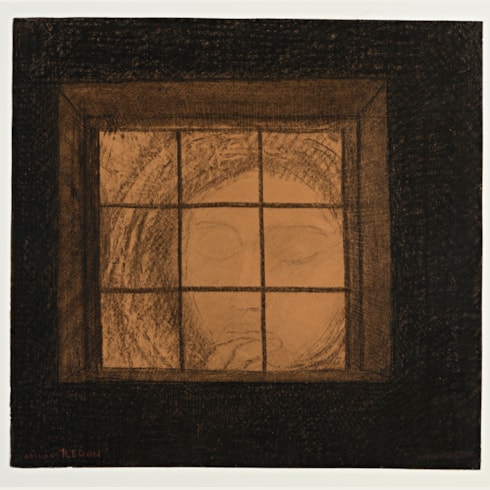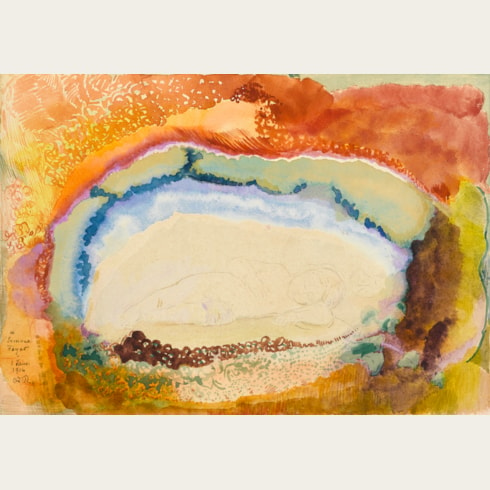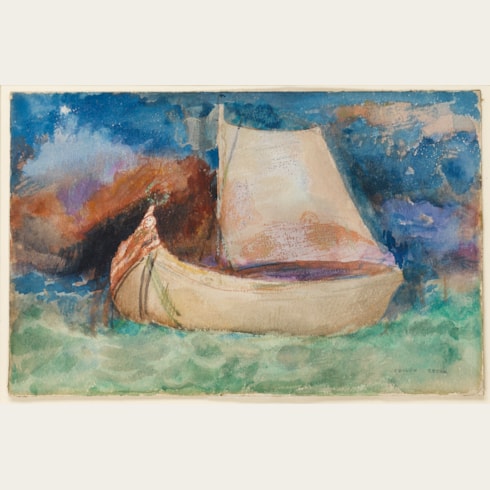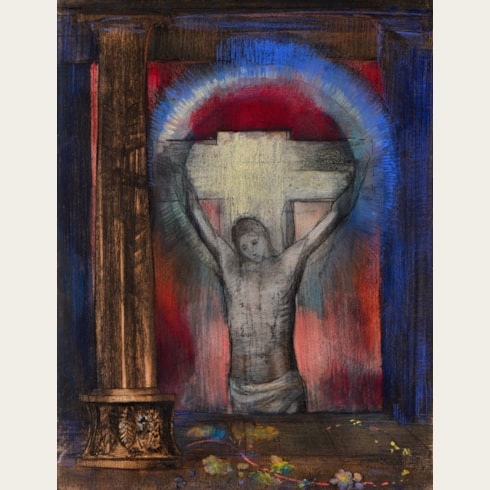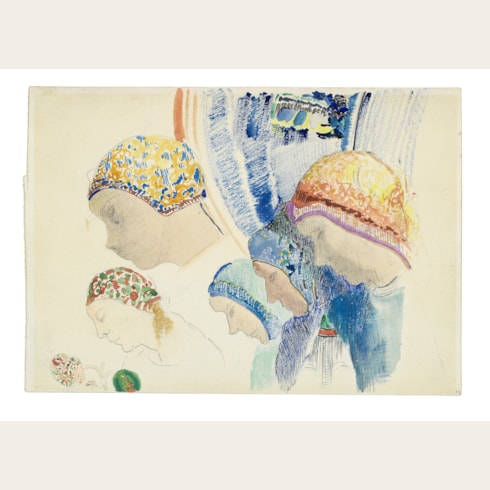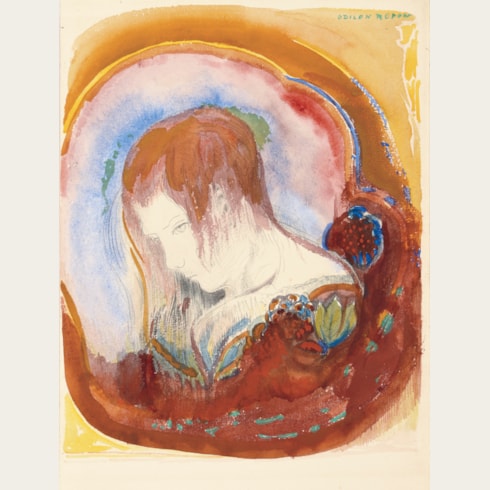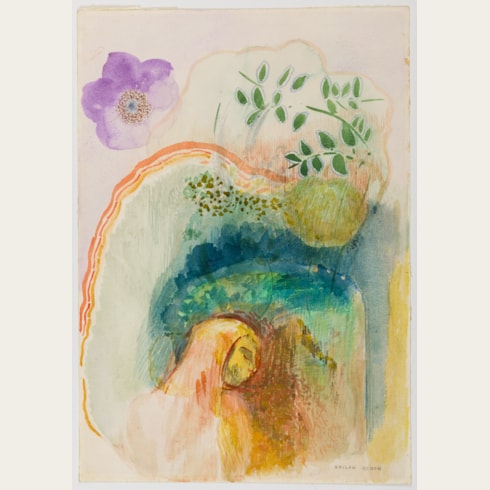Odilon REDON
(Bordeaux 1840 - Paris 1916)
Horned Figure (Figure cornue)
Sold
Pastel and charcoal on buff paper.
Signed ODILON REDON at the lower right.
372 x 271 mm. (14 5/8 x 10 5/8 in.)
Signed ODILON REDON at the lower right.
372 x 271 mm. (14 5/8 x 10 5/8 in.)
In an autobiographical account written near the end of his life, Odilon Redon noted that, ‘I believe I have given in docilely to the secret laws which prompted me to create – as best as I could, and according to my dreams – things into which I put all of myself...My originality consists in bringing to life, in a human way, improbable beings and making them live according to the laws of probability, by putting – as far as possible – the logic of the visible at the service of the invisible.’
Drawn in a combination of pastel and charcoal, the enigmatic subject of the present sheet is almost unique in Redon’s oeuvre. A similar horned head appears in the artist’s small painting Têtes, although the horned man in this large pastel is very different in character from the somewhat sinister aspect of the head in the painting. The head in this pastel also differs in mood and effect from that of a satyr with small horns and a lascivious expression in a ‘noir’ drawing of 1877 in a private collection, which, like the present sheet, was once part of the exceptional collection of Redon drawings belonging to the Baron de Domecy. Instead, the large eyes and gentle expression of the horned man in this pastel would appear to characterize the figure as one of wisdom and experience. The glowing orb drawn in shades of green and red pastel at the lower left, just above the figure’s shoulder, seems to anticipate the motif of a brightly coloured aura or nimbus that occurs repeatedly in Redon’s paintings, watercolours and pastels, particularly during the second decade of the 20th century.
The first owner of this large and striking pastel was one of Redon’s foremost patrons and collectors, Baron Robert de Denesvre de Domecy (1862-1946). The Baron had first met the artist in 1893, when he accompanied André Mellerio on a visit to his studio, and he immediately began to collect his charcoal drawings. He also attended the regular gatherings of writers, composers and collectors that Redon hosted at his home in Paris, and in December 1900 invited the artist to travel with him to Florence and Venice. An avid collector of Redon’s works on paper, Domecy acquired several charcoal drawings and lithographs, including a number of coveted and rarer ‘noirs’ from the 1870s from the artist’s own collection. He was also one of the first collectors to acquire Redon’s pastels, and by 1900 owned some ten works in pastel by him. In the same year he commissioned the artist to paint a series of eighteen large decorative panels of landscapes, trees and floral motifs for the dining room of the Château de Domecy, in Sermizelles in the Bourgogne-Franche-Comté region of France, which were completed between 1900 and 1901. (Fifteen of the panels were acquired in 1988 by the Musée d’Orsay in Paris.) This was Redon’s first large decorative cycle, and its success led to further commissions and established the artist as a decorative mural painter. Robert de Domecy also commissioned from Redon portraits of his wife Cécile in both oil and pastel, now in the Musée d’Orsay and the J. Paul Getty Museum in Los Angeles, respectively, as well as portrait drawings, in pastel or charcoal, of several of his children.
Drawn in a combination of pastel and charcoal, the enigmatic subject of the present sheet is almost unique in Redon’s oeuvre. A similar horned head appears in the artist’s small painting Têtes, although the horned man in this large pastel is very different in character from the somewhat sinister aspect of the head in the painting. The head in this pastel also differs in mood and effect from that of a satyr with small horns and a lascivious expression in a ‘noir’ drawing of 1877 in a private collection, which, like the present sheet, was once part of the exceptional collection of Redon drawings belonging to the Baron de Domecy. Instead, the large eyes and gentle expression of the horned man in this pastel would appear to characterize the figure as one of wisdom and experience. The glowing orb drawn in shades of green and red pastel at the lower left, just above the figure’s shoulder, seems to anticipate the motif of a brightly coloured aura or nimbus that occurs repeatedly in Redon’s paintings, watercolours and pastels, particularly during the second decade of the 20th century.
The first owner of this large and striking pastel was one of Redon’s foremost patrons and collectors, Baron Robert de Denesvre de Domecy (1862-1946). The Baron had first met the artist in 1893, when he accompanied André Mellerio on a visit to his studio, and he immediately began to collect his charcoal drawings. He also attended the regular gatherings of writers, composers and collectors that Redon hosted at his home in Paris, and in December 1900 invited the artist to travel with him to Florence and Venice. An avid collector of Redon’s works on paper, Domecy acquired several charcoal drawings and lithographs, including a number of coveted and rarer ‘noirs’ from the 1870s from the artist’s own collection. He was also one of the first collectors to acquire Redon’s pastels, and by 1900 owned some ten works in pastel by him. In the same year he commissioned the artist to paint a series of eighteen large decorative panels of landscapes, trees and floral motifs for the dining room of the Château de Domecy, in Sermizelles in the Bourgogne-Franche-Comté region of France, which were completed between 1900 and 1901. (Fifteen of the panels were acquired in 1988 by the Musée d’Orsay in Paris.) This was Redon’s first large decorative cycle, and its success led to further commissions and established the artist as a decorative mural painter. Robert de Domecy also commissioned from Redon portraits of his wife Cécile in both oil and pastel, now in the Musée d’Orsay and the J. Paul Getty Museum in Los Angeles, respectively, as well as portrait drawings, in pastel or charcoal, of several of his children.
At a very young age, Odilon Redon was sent to live with an old uncle at Peyrelebade, a vineyard and estate surrounded by an abandoned park in a barren area of the Médoc region, northwest of Bordeaux. Here the young boy, who suffered from frail health and epilepsy, was to spend much of his childhood in relative solitude. Indeed, it was not until he was eleven that he was sent to school in Bordeaux, where at fifteen he began to take drawing classes. The most important influence on the young artist was Rodolphe Bresdin, whose studio in Bordeaux he frequented, and who was to prove decisive on his artistic development. It was from Bresdin, for example, that Redon learned the techniques of etching and lithography. Nevertheless, for most of his career Redon worked in something of an artistic vacuum, aware of the work of his contemporaries but generally preferring to follow his own path. His drawings and prints allowed him to express his lifelong penchant for imaginary subject matter, and were dominated by strange and unsettling images of fantastic creatures, disembodied heads and masks, solitary eyes, menacing spiders and other dreamlike forms. For much of the first thirty years of his career Redon worked almost exclusively in black, producing his ‘noirs’ in charcoal and chalk; the drawings he described as ‘mes ombres’, or ‘my shadows’.
It was not until 1881, when he was more than forty years old, that Redon first mounted a small exhibition of his work, to almost complete indifference on the part of critics or the public. The following year, however, a second exhibition of drawings and lithographs brought him to the attention of a number of critics. Redon’s reputation began to grow, and in 1884 he exhibited at the first Salon des Indépendants, which he had helped to organize. Two years later he was invited to show at the eighth and final Impressionist exhibition, and in the same year exhibited with Les XX, a group of avant-garde artists, writers and musicians in Brussels.
Towards the end of the 19th century Redon began to move away from working mainly in charcoal and black chalk in favour of a new emphasis on colour, chiefly using the medium of pastel but also watercolour, oil paint and distemper. Indeed, after about 1900 he seems to have almost completely abandoned working in black and white. Like his noirs, his pastels of floral still lives and portraits were popular with a few collectors, and several were included in exhibitions at Durand-Ruel in 1900, 1903 and 1906, and in subsequent exhibitions of his work in Paris and abroad. Despite this change in direction, however, Redon’s work remained unpopular with the public at large, and it was left to a few enlightened collectors to support the artist in his later years. Nevertheless, an entire room was devoted to Redon at the seminal Armory Show held in New York in 1913, an honour shared by Cezanne, Gauguin, Matisse and Van Gogh.
Provenance
Given by the artist to Baron Robert de Denesvre de Domecy, Château de Domecy-sur-le-Vault, Sermizelles, Yonne
Thence by descent in the Denesvre de Domecy collection
Anonymous sale, Cheverny, Philippe Rouillac, 6 June 1999, lot 70
Private collection
Anonymous sale, New York, Christie’s, 7 November 2001, lot 416
Paul Allen, Mercer Island, Seattle.
Thence by descent in the Denesvre de Domecy collection
Anonymous sale, Cheverny, Philippe Rouillac, 6 June 1999, lot 70
Private collection
Anonymous sale, New York, Christie’s, 7 November 2001, lot 416
Paul Allen, Mercer Island, Seattle.
Literature
To be included in the supplement to Alec Wildenstein’s Odilon Redon: Catalogue raisonné de l’oeuvre peint et dessiné.






